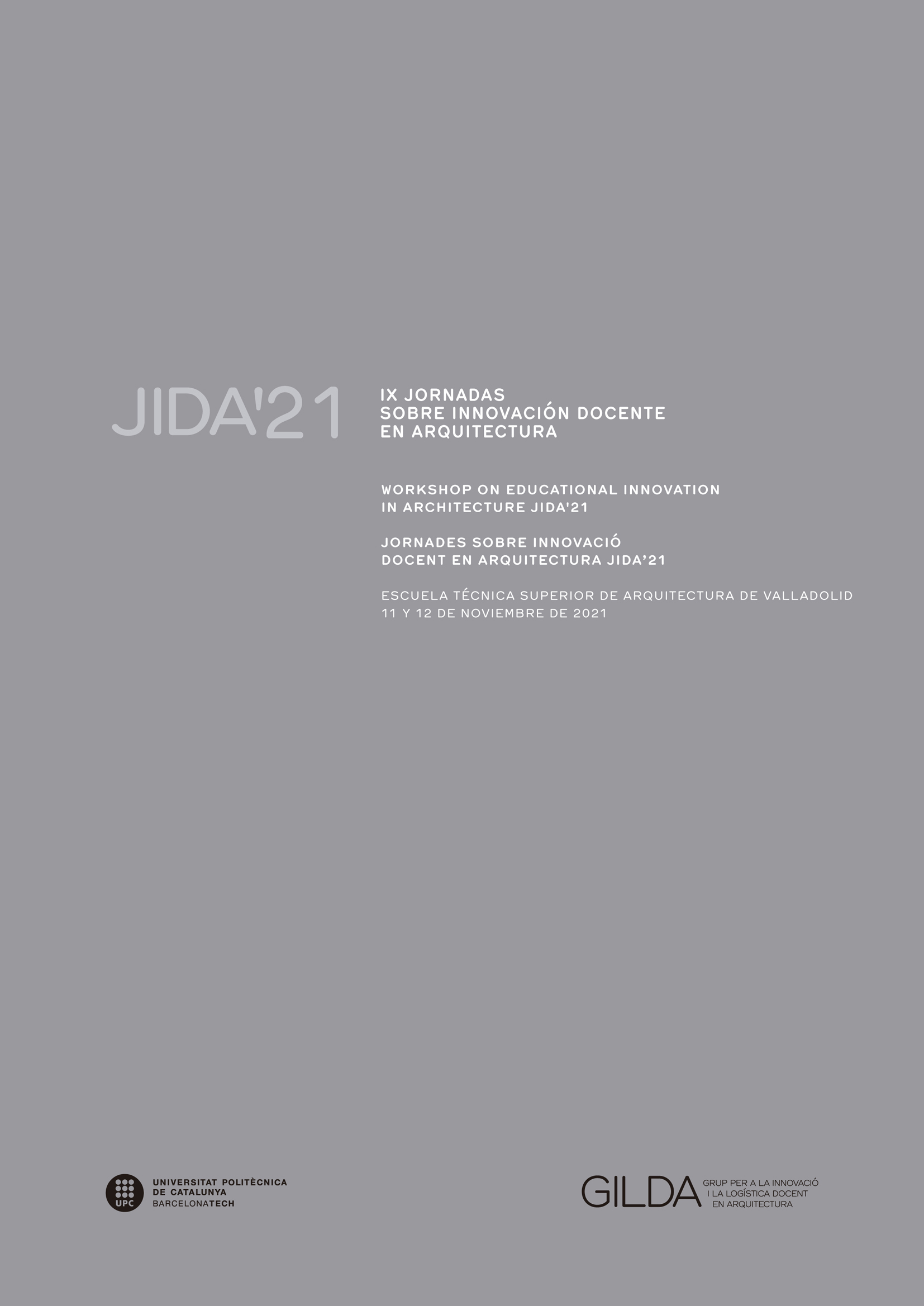Paisajes Encontrados: docencia remota y pedagogías experimentales confinadas
DOI:
https://doi.org/10.5821/jida.2021.10590Palabras clave:
docencia confinada, aprendizaje experimental, espacio de aprendizaje, arte conceptual, giro del espacioResumen
En el contexto sanitario de confinamiento y docencia remota, la propuesta de pedagogías experimentales en ambientes confinados, aplicado a un ejercicio del primer curso de Proyectos de Arquitectura, indaga en el impacto de entornos de aprendizajes activados desde procesos y métodos del Arte Conceptual, Objeto Encontrado de Duchamp, Matta Clark, Graham, entre otros, interpelando a que, incorporando la experiencia vivida de lugares, paisajes y territorios que circundan a cada estudiante, valiéndose del confinamiento, será posible construir una experiencia de aprendizaje significativo desde el aprendizaje autónomo y el desarrollo del pensamiento creativo. Repasamos en sus claves pedagógicas, en una tradición en la arquitectura que incorpora el constructivismo y las teorías que estudian el conocimiento adquirido desde la experiencia. Bases, entre otras, consideradas como un soporte para comprender los aportes Kolb y el Ciclo del Aprendizaje, y las que se constituyen en el fundamento de la propuesta que aquí se expone.
Citas
AGUILAR ALEJANDRE, M. (2020). La Plataforma de Anna y Lawrence Halprin, Un Suelo para el Nacimiento de la Danza Contemporánea. Revista Proyecto Progreso Arquitectura, Nº23. Editorial Universidad de Sevilla.
AUSUBEL, D.; NOVAK, J.; y HANESIAN, H. (1983). Psicología Educativa: Un punto de vista cognoscitivo. 2° Ed. TRILLAS México.
CARRASCO, M. (2013). De la estética de la forma a la estética del significado. Sobre el giro estético de A. Danto. Revista de Filosofía, 38(1) Murcia. España.
CRIADO-BOADO, F. (1989). Megalitos, espacio, pensamiento. Trabajos de Prehistoria, 46: 75-98.
DANTO, A. (2002). (Primera Edición 1981). La Transfiguración del lugar común. Ediciones Paidós. Barcelona.
DANTO, A. (2005). El abuso de la Belleza, Barcelona, Paidós.
KRAUSS, R. (1979). La escultura en el campo expandido. Editorial Paidós, Barcelona.
MADERUELO, J. (2009). Paisaje e Historia. Madrid: Ed. Abada
MASEY, D. (2005). For Space. SAGEY Publications Ltd. London.
MILLAN PASCUAL, R, et al. (2021). Materialidades, espacio, pensamiento: arqueología de la cognición visual. Trabajos de Prehistoria 78, N.o 1, enero-junio 2021, pp. 7-25, ISSN: 0082-5638. <https://doi.org/10.3989/tp.2021.12262>
MUÑOZ GUTIERREZ, C. (2010). La Metafísica del Espacio. En encuentro de Heidegger con Chillida. Revista de Filosofía. A Parte Rei /0. Julio 2010.
NOGUÉ i FONT, J. (1985 A). Un mètode de treball humanista. Documents d’Análisi Geográfica, 6, 1985. Barcelona. Catalunya.
NOGUÉ i FONT, J. (1985 B). Geografía humanista y paisaje. Anales de Geografía de la Universidad Complutense, Nº5, pp. 93-107. Madrid.
NOGUÉ i FONT, J. (1984). Géographie humuniste et paysage. Une lecture humuniste du paysage de la Garrotxa. Tesis Doctoral Universidad Autónoma de Barcelona. Catalunya.
LAGOS, R. (2012). El concepto del campo expandido. Revista Generación Abierta. Nro. 63.
SALDAÑA PARIS, D. (2006). Gordon Matta-Clark: Los edificios son para comer. Consultado: Septiembre 2021. En: https://www.letraslibres.com/mexico-espana/gordon-matta-clark-los-edificios-son-comer>
SIMEOFORIDIS, Y. (2001). Notas Para una Historia Cultural entre la Incertidumbre y la Condicion Urbana Contemporánea. Mutaciones. Ediciones Arc En Reve Centre D’architecture.
SOJA, E. (2008). Postmetropolis. Estudios críticos sobre las ciudades y las regiones. Edición Traficantes de Sueños
SWARTZ, R., et al. (2013). El aprendizaje basado en el pensamiento. Cómo desarrollar en los alumnos las competencias del siglo XXI. Madrid: SM
TISHMAN, S.; PERKINS, D.; y JAY, E. (1994). Un aula para pensar: Aprender y enseñar en una cultura de pensamiento. Buenos Aires: Aique.
TURRI, E. (1998). Il paesaggio comme teatro. Dal territorio vissuto al territorio rapresentato. Editorial Marsilio. Venezia. Italia.
VÁSQUEZ ROCCA, A. (2021). Joseph Beuys: de la antropología al concepto ampliado de arte. Consultado septiembre. En: <http://philosophyreview.blogspot.com/2008/08/joseph-beuys-de-la-antropologa-al.html>
WATSUJI, T. (2006). Antropología del Paisaje. Climas, culturas y religiones. Ediciones Sígueme S. A. U. Salamanca.
YOUNG, F.; TUCKWELL, D.; y CLEVELAND, B. (2021). Actualising the affordances of innovative learning environments through co-creating practice change with teachers. Aust. Educ. Res. <https://doi.org/10.1007/s13384-021-00447-7>






















